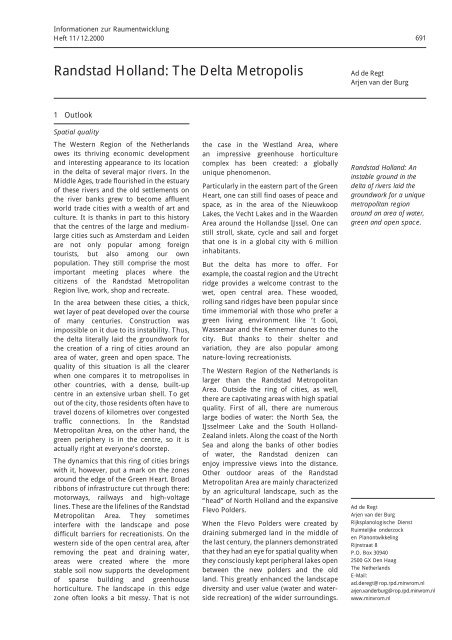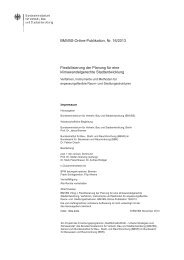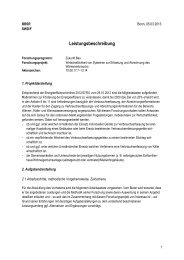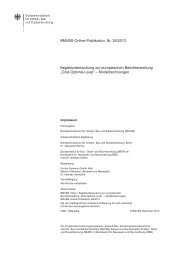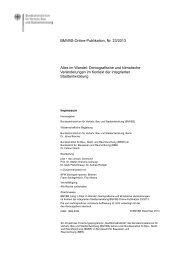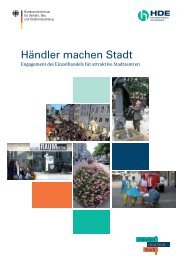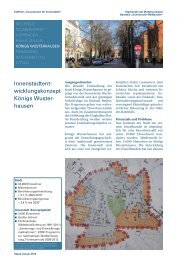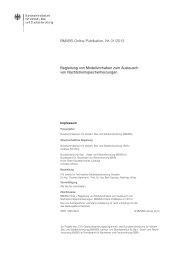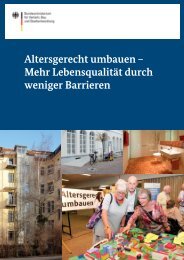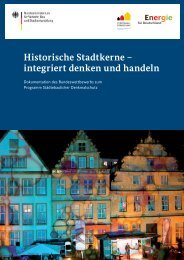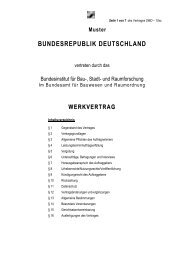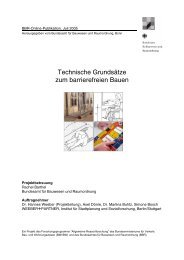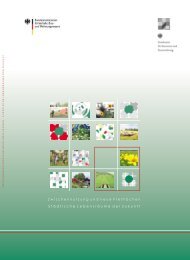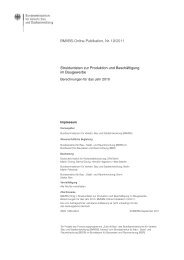Download (PDF, 1MB, Not barrier-free file.)
Download (PDF, 1MB, Not barrier-free file.)
Download (PDF, 1MB, Not barrier-free file.)
Create successful ePaper yourself
Turn your PDF publications into a flip-book with our unique Google optimized e-Paper software.
Informationen zur RaumentwicklungHeft 11/12.2000 691Randstad Holland: The Delta MetropolisAd de RegtArjen van der Burg1 OutlookSpatial qualityThe Western Region of the Netherlandsowes its thriving economic developmentand interesting appearance to its locationin the delta of several major rivers. In theMiddle Ages, trade flourished in the estuaryof these rivers and the old settlements onthe river banks grew to become affluentworld trade cities with a wealth of art andculture. It is thanks in part to this historythat the centres of the large and mediumlargecities such as Amsterdam and Leidenare not only popular among foreigntourists, but also among our ownpopulation. They still comprise the mostimportant meeting places where thecitizens of the Randstad MetropolitanRegion live, work, shop and recreate.In the area between these cities, a thick,wet layer of peat developed over the courseof many centuries. Construction wasimpossible on it due to its instability. Thus,the delta literally laid the groundwork forthe creation of a ring of cities around anarea of water, green and open space. Thequality of this situation is all the clearerwhen one compares it to metropolises inother countries, with a dense, built-upcentre in an extensive urban shell. To getout of the city, those residents often have totravel dozens of kilometres over congestedtraffic connections. In the RandstadMetropolitan Area, on the other hand, thegreen periphery is in the centre, so it isactually right at everyone’s doorstep.The dynamics that this ring of cities bringswith it, however, put a mark on the zonesaround the edge of the Green Heart. Broadribbons of infrastructure cut through there:motorways, railways and high-voltagelines. These are the lifelines of the RandstadMetropolitan Area. They sometimesinterfere with the landscape and posedifficult <strong>barrier</strong>s for recreationists. On thewestern side of the open central area, afterremoving the peat and draining water,areas were created where the morestable soil now supports the developmentof sparse building and greenhousehorticulture. The landscape in this edgezone often looks a bit messy. That is notthe case in the Westland Area, wherean impressive greenhouse horticulturecomplex has been created: a globallyunique phenomenon.Particularly in the eastern part of the GreenHeart, one can still find oases of peace andspace, as in the area of the NieuwkoopLakes, the Vecht Lakes and in the WaardenArea around the Hollandse IJssel. One canstill stroll, skate, cycle and sail and forgetthat one is in a global city with 6 millioninhabitants.But the delta has more to offer. Forexample, the coastal region and the Utrechtridge provides a welcome contrast to thewet, open central area. These wooded,rolling sand ridges have been popular sincetime immemorial with those who prefer agreen living environment like ‘t Gooi,Wassenaar and the Kennemer dunes to thecity. But thanks to their shelter andvariation, they are also popular amongnature-loving recreationists.The Western Region of the Netherlands islarger than the Randstad MetropolitanArea. Outside the ring of cities, as well,there are captivating areas with high spatialquality. First of all, there are numerouslarge bodies of water: the North Sea, theIJsselmeer Lake and the South Holland-Zealand inlets. Along the coast of the NorthSea and along the banks of other bodiesof water, the Randstad denizen canenjoy impressive views into the distance.Other outdoor areas of the RandstadMetropolitan Area are mainly characterizedby an agricultural landscape, such as the“head” of North Holland and the expansiveFlevo Polders.When the Flevo Polders were created bydraining submerged land in the middle ofthe last century, the planners demonstratedthat they had an eye for spatial quality whenthey consciously kept peripheral lakes openbetween the new polders and the oldland. This greatly enhanced the landscapediversity and user value (water and watersiderecreation) of the wider surroundings.Randstad Holland: Aninstable ground in thedelta of rivers laid thegroundwork for a uniquemetropolitan regionaround an area of water,green and open space.Ad de RegtArjen van der BurgRijksplanologische DienstRuimtelijke onderzocken PlanontwikkelingRijnstraat 8P.O. Box 309402500 GX Den HaagThe NetherlandsE-Mail:ad.deregt@rop.rpd.minvrom.nlarjen.vanderburg@rop.rpd.minvrom.nlwww.minvrom.nl
692Ad de Regt, Arjen van der Burg: Randstad Holland: The Delta MetropolisRandstad Holland: Theneed for space will bean urgent futurechallenge, accompaniedby the need for furtherprotection and developmentof spatial, urbanand economic qualities.Looking back on all of this, it is clear howunique the Western Region of theNetherlands is – given its combination ofhigh-density urbanization and a range ofscenic delta qualities. As the Randstadexpands further to become a DeltaMetropolis, it is crucial to proceed from thisprinciple in development planning for thewestern part of our country. For this reason,the Delta Metropolis has been designatedas a “Grand Project” in the ArchitecturePolicy Document.Problem definition and tasksThe Western Region will be faced with quitea challenge in the decades to come:improvement of the spatial quality inthe Randstad Metropolitan Area incombination with meeting a high demandfor new homes, jobs, facilities and access tothem. This places a great deal of pressureon spatial planning, both for the urban andgreen spaces. But at the same time, thisdynamic is a perfect opportunity to addressflaws in quality.Can the West meet its own need for space inthe future? And if so, at what price? Theanswer to this question not only pertains tothe relationship between the WesternRegion of the Netherlands and the otherparts of the country, it is also contingent onthe position that we in the West – andindirectly, in the Netherlands – ascribe tothe international economy.There is stiff competition globally betweenurban regions. The role of an economygeared towards knowledge is increasing.Knowledge-intensive businesses, branchesof globally operating corporations andbusinesses that are highly oriented towardsinnovation (of products and technologies,in information and communicationsprocesses and in meeting consumerdemands) are seeking centres of excellence,where they are not too far removed fromeach other. These centres must be easilyaccessible from the rest of the world. TheRandstad Metropolis is just such a centre.But its position is not unthreatened. Othercentres outside of our country arereinforcing their spatial qualities. Theyare doing so in a broad sense. Theattractiveness of a place for business isconnected, after all, with the living climate.That climate can deteriorate, not so muchas a result of growth itself, but due to a lackof order and cohesion, creatingbottlenecks, inequalities or the feeling thatthe limits of possibilities have beenreached, even when this is actually not thecase.In many places in the Randstad Region,there is spectacular growth in the built-uparea. There is a need for more cohesionbetween these developments, morecoordination. Filling that coordination role,as well as restoring and making sustainablethe balance between city and country: thatis the main task of the Western Region.Of course, such a task requires that choicesbe made. In the Randstad Region, much ispossible, but not everything and noteverything at the same time. Translatingthat understanding into policy choices isessential for the preservation of thenational and international position ofthe Randstad Region and to achievesustainability of both employmentopportunities and the living climate in thispart of the Netherlands.Need for spaceFor the Western Region, as well, it is theplan to meet the need for space created bythe growth expected in the region itself.Based on the citizen recommendations, itappears that many Randstad residents feelthat the Randstad Region is full. There isa desire to accommodate some of thedemand for urbanization elsewhere in thecountry and to create extra space for natureand recreation. A great deal of importanceis also attached to accommodating extraneeds for space within existing cities andvillages and to make more intensive use ofexisting business parks, in order to preserveexisting valuable green spaces such as theGreen Heart.This topic has been discussed extensivelywith the Randstad Region. The questionwas explored whether the urbanizationdemand could be fit in a way that couldyield good spatial quality. This questionwas answered in the affirmative, despiteseveral investment problems and difficultincorporation issues that will be explainedin more detail below.
Informationen zur RaumentwicklungHeft 11/12.2000 693Map 1Geography of the Delta MetropolisSpatial pattern of landusebuilt up areawooded areagrasslandarable landnon-cultivated areaNetworksmotorwayintersectionslip roadmain roadhigh speed railwayrailway: double- and multitrackrailway: single-trackrailway station0 5 10 2550 km.Subsoilferry linkoffshore platformwaterdepth10 20 30 40 50 meter - NAPprovince-boundarysubdivision-boundaryinternational airportVijfde <strong>Not</strong>a Ruimtelijke Ordening, 2001 - © ministerie van Volkshuisvesting Ruimtelijke Ordening en MilieubeheerBronnen: - Kaart 14 - Rijksplanologische Dienst
694Ad de Regt, Arjen van der Burg: Randstad Holland: The Delta MetropolisDelta Metropolis: a newpolicy framework tomeet these challenges.2 Policy choicesSpatial view: the Delta MetropolisThe Randstad Region has set down itsbeginnings of a spatial view in the report“The Randstad Region on the Way to theFourth Report. From Principles to Views”(December 1999) plus the “Conditions for aGreen Delta Metropolis” (September 2000).The general starting point in this view isthat, more than ever before, policy must begeared towards reinforcing the Randstadregion’s function as a centre in theNorthwest European economic networksand as an anchor point within the spatial /economic main structure.The Cabinet ascribes to this view. The draftDelta Metropolis is a challenging, integraljob for spatial planning, infrastructure andnature development. It is an expressionof the ambition to stimulate furtherintertwining of the component areas of theRandstad Region, whereby they willfunction as more than a sum of their parts.The level of economic specialization and ofall kinds of facilities in an urban area aredetermined to a large degree by the scope,the support. A city that is twice as large doesnot only have twice as many businesses,schools and shops in general, but also theyare of a higher level and more specialized.The Randstad Region as a whole hasadequate critical mass, when one looks at itthis way, to function at the level of othermajor urban European regions; individualareas within the Randstad Region do not,however, have that critical mass.Where do the greatest opportunities lie? Inthe international competition betweenregions, the environment for internationallyoperating businesses to set upshop plays a key role. For foreigncompanies and (Dutch) exportingcompanies, an excellent businessMap 2.1The Delta Metropolis:its component greenVijfde <strong>Not</strong>a Ruimtelijke Ordening, 2001 - © ministerie van Volkshuisvesting Ruimtelijke Ordening en Milieubeheer0 5 10 25 50 100 km.
696Ad de Regt, Arjen van der Burg: Randstad Holland: The Delta MetropolisFor typical R&D activities, the presence of(other) knowledge institutions is decisive.They sometimes are located in urban areas(such as TU and TNO in Delft) andsometimes in an attractive landscape(ESTEC in Noordwijk). Universities andother knowledge institutions areindispensable for urban regions. Thespatial scale of spin-offs from them can beexpected to be very large.The above means that the Randstad Regionmust offer environments for a range ofinternationally operating businesses toestablish themselves in the future. Theseare: urban environments for businessservices and urban tourism, urban andgreen environments for R&D institutions,logistic hubs (International airports andinternational seaports) and regionsadjacent to seaports for heavy (chemical)industry.If the Randstad Region were to achieve aleading position among the urban areas ofEurope, that would impact the investmentclimate and development of prosperity, thequality of employment, the attractivenessof facilities, and the richness of culturalprogrammes offered. That is very importantfor the quality of life in the RandstadRegion, and given its function as a centre,for the rest of the country, as well.Spatial interweaving is achieved bystrengthening the relationship networks:the green-blue network and theinfrastructure network. The green-bluenetwork is about strengthening and makingvisible the unique delta character ofthe Randstad Region. Through theinfrastructure network, the residents andcompanies in the Randstad Region cancommunicate with each other quickly,safely and comfortably. In this way, themetropolitan ambition can be madeconcrete for the Randstad Region.Map 2.3The Delta Metropolis:its component networksVijfde <strong>Not</strong>a Ruimtelijke Ordening, 2001 - © ministerie van Volkshuisvesting Ruimtelijke Ordening en Milieubeheer0 5 10 25 50 100 km.
Informationen zur RaumentwicklungHeft 11/12.2000 697The image of the spatial main structure ofthe western part of the country, based onthe development of two more or lessautonomous mainports, nine city districtsand a series of regional cores and bufferzones is being replaced by one concept.The Delta Metropolis is the new policyframework for a broad range of urban, ruraland green environments in a characteristicriver delta with expansive views ofmeadows, cows, windmills and cloudyskies. But it is also a delta with citysilhouettes and landmarks as well as anArena and a well-designed high-speed raillink (HSL) route. The Delta Metropolis alsocreates the framework for powerfulcombinations of infrastructure that can beused efficiently to strike a good balancebetween road and rail infrastructure. Byusing techniques such as superstructuresover and tunnels under motorways, and bybuilding ecoducts, the human scale can berestored and nature can be preservedwithin the metropolis. The places for newbuilding investments are not chosenrandomly or in an excessively decentralizedmanner, but in connection with and for theDelta Metropolis as a whole. By achievingboth thinning and densification, promotingintensive and multifunctional land use andrestructuring vulnerable parts of the urbanand green space, the Randstad Region candevelop to become one of the most liveable,attractive and functional metropolises inthe world.This orientation is supported by the choiceof continuous concentrated urbandevelopment, on and around the urbanring. This intensification makes it possibleboth on and in the ring to develop the“green” qualities more strongly througha system of parks, nature areas,easily accessible agricultural areas andrecreational areas on the coast and alongMap 2.4The Delta Metropolis:its component waterVijfde <strong>Not</strong>a Ruimtelijke Ordening, 2001 - © ministerie van Volkshuisvesting Ruimtelijke Ordening en Milieubeheer0 5 10 25 50 100 km.
698Ad de Regt, Arjen van der Burg: Randstad Holland: The Delta MetropolisDelta Metropolis meansan integral job for spatialplanning, infrastructureand nature developmentwithin a broad regionaland even nationalnetwork.the water. This leaves space for land-boundfarming around villages that maintain theirown character.In an urban network with increasinginteractions, passenger transport willcontinue to increase, and thus mobility.Good spatial and environmental qualityrequires an internal public transportnetwork that competes with automobiletraffic, functioning as an underground trainsystem that is fast, reliable, with many stopsand a high frequency.The Delta Metropolis is not an isolatedarea, but is connected to other areas in andoutside of the Netherlands. Intensiverelationships exist with the national urbannetworks in the Eastern Region of theNetherlands (Twente, Arnhem / Nijmegen)and in the Southern Region of theNetherlands (series of cities in BrabantRegion). The relationships with both othernational urban networks (Groningen /Assen and Maastricht / Heerlen / Aachen /Liège) will become more and moreintensive due to European developmentsand new transport connections.Those relationships require more capacityexpansion for traffic and the addition ofsome lacking links, such as the connectionto the North by rail. In addition, severalpoints of the ecological connections will bestrengthened. At the level of the RandstadRegion as a whole, it is about the ecologicalconnections between the Wadden Sea viathe IJsselmeer Lake and the Green Hearttowards the Zealand Delta and the greatrivers, and the links between the CoastalRegion, the Green Heart and the UtrechtRidge.This spatial view of the Delta Metropolis iselaborated upon in the next three sectionsbased on the green-blue network, theinfrastructure and the urban network, inthat order.Outside the urban network of the DeltaMetropolis, the Western Region includesurban areas such as the Northern District(Alkmaar and environs), which willaccommodate their own growth on thebasis of a good infrastructure link to theDelta Metropolis. Waterland, locatedbetween the Northern District and theDelta Metropolis, comprises a protectednational landscape, together with Wormer,Beemster and Schermer, and will bekept <strong>free</strong> of new infrastructure andurbanization.Finally, outside the Delta Metropolis in theWestern Region, there are several ruralareas with a primarily agricultural function,such as the head of North Holland,Flevoland and the South Holland islands.Of these areas, de Hoeksche Waard is to bedeveloped as a national landscape. Largebodies of water with special nature valueoutside the metropolis include theIJsselmeer Lake and its peripheralRandmeren Lakes, the Wadden Sea, theinlets and parts of the coastal region(including Texel and Voorne).The Green-Blue NetworkThe central guideline for the spatialdevelopment of the metropolis is the deltacharacter. This requires the restoration andreinforcement of cohesion in the greenbluenetwork of ecological connectionzones, water systems and gradients, andcontinuity in recreational routes.The Green-Blue Network begins at thedoorstep of the urban area. In order toactually live up to this, quite a few <strong>barrier</strong>smust yet be eliminated, such as clutteredcity outskirts and combinations ofinfrastructure. The network includes bothinner-city green areas and regional greenzones (formerly buffer zones) as well asthe Green Heart as a national landscape.So it includes both traditional parksand complete landscapes in whichnumerous agricultural companies handlemanagement jointly. The target isto create an extra 5,000 or so hectares ofwater surface and an equivalent surfacearea of green area (in addition to existingagreements). Green-blue connectionsbetween the city and country are to berestored or improved. The focus of thisprogramme is the development of regionalgreen zones (former buffer zones) and thewestern peripheral zone of the Green Heart.The heights of all kinds of urban buildingsin the Delta Metropolis are increasing. Thisfits in a highly urbanized area, but alsoimpacts the perception of the green openspaces. The situations in which buildingheights should be restricted in order toprevent deterioration of the view of thetypical delta qualities are being examined.It is important for these buildings to beattractive, too, not just shoeboxes, and thatconstruction maintains a human scale forthe passer-by on the street.
Informationen zur RaumentwicklungHeft 11/12.2000 699The Green HeartThe Green Heart offers the possibility oflavishly experiencing contrasting qualitiessuch as peace, quiet and green, in adynamic metropolis. An explicit choice hasbeen made for the fen meadow area tomaintain the historic cultivation and tocontinue agricultural land use. Large-scaleswamp development is to be abated. Soilsubsidence, greatly increased due tolowering of the water table since World WarII, must be checked. An expansion of theregional water storage capacity is targetedby strategically utilizing level fluctuations(high in winter, low in summer), greatlyreducing the need for letting water in andout. In addition, extra storage capacity isneeded for emergencies, which capacitywill be achieved to a great extent by 2030.As a result of this water challenge andglobal market developments, the landbounddairy farms will be put underpressure. A sustainable future for thisindustry requires restructuring and atransition to quality production with aregional sales market, expansion ofbusiness activities, extensification andspatial scale expansion. That requiresmajor investments.In the western part of the Green Heart,where the majority of the land is comprisedof claimed lakes, the water-storing capacityis to be increased by expanding existing andcreating new polder pools, ponds and lakes.The Green Heart is not one uniform entity,but consists of component parts withconsiderable differences in spatial quality,opportunities and threats. In order toachieve the development and investmentplan in an effective way, a differentiatedapproach is necessary. A distinction is tobe made between landscape units,transformation zones and expansion areas.For each of these categories, theassignment is entirely unique, but thisdifference in approach must not lead to adissection of the Green Heart into isolatedcomponent areas. On the contrary, creatingrelationships with adjacent componentareas continues to be the explicitassignment.Landscape units are areas with a relativelyuniform, not very urbanized landscape,where (land-bound) agriculture, nature,water management and recreation arejoined in a recognizable cultural andhistorical context. These oases of peace andspace are located in fen meadow areas andin the pond areas, such as Venen, Waardenand the Holland Lake Area.Transformation zones are located both inthe peripheral zones, where the GreenHeart borders on the city ring, and aroundthe infrastructure ribbons that intersect theGreen Heart.Particularly on the western side of theGreen Heart, several transformation zonesare distinguished, such as the ZuidplasPolder and the southern part of theHaarlemmermeer Polder. These areas areunder pressure both as a result of thedynamics of the adjacent urban area as wellas intensification by agriculture. Robustrestructuring is desired here, through acohesive development of nature, recreationand water management, in which thegreen-blue qualities are to be enhanced. Itis possible that some degree of high-qualityurbanization will be implemented in theperipheral zones. That goes particularly forthese peripheral zones but not for thetransformation zones along the maininfrastructure. There, the recreational andecological relationships between theadjacent landscape units are to be restoredand the vistas across the open fen meadowareas from the motorways and trains are tobe visible (again). Urban developmentssuch as “sight locations” are to beenergetically opposed in these zones.Like the transformation zones, expansionareas are found on the periphery of theGreen Heart. The scope of the developmenttask for these areas is smaller and consistsmainly of adding smaller forest andrecreation elements and bodies of waterthat are easily accessible from residentialareas.The ring of citiesIn the urban network, too, the green / bluecomponent is to be reinforced: The linkingof smaller and larger green areas, where thegreen belt in the cities is linked by a systemof regional green zones with the GreenHeart and the large landscape units on theouter side of the Delta Metropolis. Inconnection with urban restructuring, allpossibilities will be utilized to expand thecapacity for water storage. There are goodprospects, especially in residential districtswhere more green living environments areto be created through thinning. These arealso to be found elsewhere through theThe main components ofDelta Metropolis are: anetwork of ecologicalconnection zones, infrastructurenetworks andurban networks.
700Ad de Regt, Arjen van der Burg: Randstad Holland: The Delta Metropolisuse of other funding mechanisms. Therequirement for internal water collectionalways applies to urban expansions.New polder pools, lakes and ponds are to becreated between the cities, thus linkingexisting parks, recreational areas, natureareas and agricultural areas with eachother. In connection with that, residentialenvironments on the water – now in greatdemand – can be created. Motorways,railways, and channels now often posedifficult obstacles discouraging recreationin the form of short trips from home(without a car). Investments are needed forviaducts, tunnels, ecoducts and aqueductsand the restructuring of routes through thelandscape.The coastal region is a fairly contiguous,publicly accessible area with nature,recreation possibilities and an expansiveview. Between Hoek van Holland andScheveningen, the row of dunes is verynarrow. In combination with the creation ofthe Tweede Maasvlakte Industrial Area andan extension of the harbour peer, thechoice here is for dune expansion towardsthe sea with a highly natural character thatlends itself well to expansion of therecreational possibilities (for day-trippers).In the South Wing, there is a great demandfor this. In the Bulb Region, on the otherhand, dune expansion is sought in aninland direction, in combination with thecreation of a varied residential area andexpansion of water storage. Given theMap 3The structure of the Delta MetropolisUrban ringOpen zonesGreen corridorsSource: Rijksplanologische Diensthollow pro<strong>file</strong> of the coast line, duneexpansions from Scheveningen to Pettenmust move inland. All these developmentsfit with dynamic coast management inwhich increasing safety comes first, but incombination with high-quality use.The city ring is intersected by severalecological main connections that link theGreen Heart with green / blue spacesoutside the Delta Metropolis. The mostimportant ecological connection runs fromthe Wadden Sea, via the IJsselmeer Lakeand the Green Heart, to the South Holland-Zealand Delta: the “Wet Axis” (Natte As). Inorder not to disrupt this ecologicalrelationship, four open zones are to be kept<strong>free</strong> of urbanization in the Randstad Regionring.The infrastructure networkIn order to function as one urban whole, theDelta Metropolis has to have a goodinfrastructure network. This connects thedifferent parts of the Delta Metropolisquickly, safely and comfortably with eachother and other parts of our country.Excellent overland connections are alsoneeded with nearby metropolises, i.e. theFlemish Diamond Area, the Rhine / RuhrArea and Frankfurt and – a little fartheraway – Paris, London, Hamburg and Berlin.Particularly for business transport, it isimportant that one can travel back andforth in one day (a maximum of 3 hours oftravel time between region peripheries).Public transport must be competitive withair and car travel when it comes to thesedistances. High-speed rail links arerequired, particularly to the three closestmetropolises and to Paris and London. TheHSL South Line is now under construction.As for the HSL East Line, it is being studiedwhether the same goal can be achieved bymodifying the existing rail for higherspeeds. In addition, good accessibility by(freight) lorry is required. The DeltaMetropolis has sufficient motorwayconnections, but the utilization, capacityand traffic flows require improvement.In order to adequately transport largegoods flows from the Rotterdam Port, theBetuwe Line is under construction. Inthe long term, the connection betweenRotterdam (Kijfhoek) and Antwerp must beimproved. There are adequate inlandwaterways of the highest quality, i.e. theAmsterdam-Rhine Canal, the Waal Riverand the Schelde-Rhine Canal.
Informationen zur RaumentwicklungHeft 11/12.2000 701Internal accessibility70 per cent of traffic movements in theRandstad Region take place within thelimits of a 10 to 20 kilometres radius arounda big city. In the future, as well, this sharewill remain high. Further improvement andextension of this part of the traffic systemtherefore has a high priority. That alsocontributes to improving connectionswithin the entire Randstad Region.Different quality requirements apply: Inaddition to travel times, these includereliability, comfort and frequency. Traveltimes are to be reduced first of all betweenthe international centres (the centres of thefour major cities and Schiphol Airport) andthen for the other centres of Randstad levellocated on the major intersection points ofthe urban network of the Randstad RegionRing and that have an Intercity railwaystation or for which one is planned. Thisincludes several centres in the inner flank ofthe ring where the economic potentials arehigh given easy access by car.In view of the urban network of the DeltaMetropolis, this also means goodconnections with other parts of the countryand adjacent metropolises are located onthe outside of the Randstad Region,strategically located centres (such asAlmere, Amersfoort and Dordrecht) thathave an Intercity railway station and forwhich short travel times to other RandstadCentres are also possible. In addition togood access by public transport, thesecentres must also be easily accessible bycar.Map 4 shows a tentative picture of the6 international and approximately 20Randstad Centres that the nationalgovernment regards as the most importantfocal points of the Delta Metropolis andwhere there are many possibilities forachieving combined, high-value centre-cityprogrammes. The national governmentinvites the region to respond to thisproposal for developing Randstad Centresby mid-2001 and thus to give insight in thespatial programmes and quality criteria foraccessibility (both by public transport andcar). Consideration must be given to theneed to develop centre environments at alower level, too, within existing built-upareas.Map 4The centres of the Delta MetropolisInternational centreRegional centreSource: Rijksplanologische Dienstto the public transport system of the DeltaMetropolis in the next decades. Railtransport is to be doubled during rushhours and frequencies are to be increased.This results in improved travel time foreach component area and the RandstadRegion as a whole. In the long run, thequestion is the way in which the publictransport system can be further expanded.In theory, there are two main directions inwhich to go:• Further reinforcement of existingforms of public transport linked tointensification of urbanization of theRandstad Ring• Addition of a new transport systemlinked to new urbanization in the flanksof the ring.Since the choice is closely connected to thenew urbanization directions in the DeltaMetropolis as a whole, it is desirable that adecision can be made. In the short term, thenational government will conduct anexploration into both the cost-effectivenessand the spatial incorporation of the mostpromising alternatives.Implementation of the current MIT andBOR packages, plus the NVVP plans, willresult in substantial quality improvements
702Ad de Regt, Arjen van der Burg: Randstad Holland: The Delta MetropolisThe urban networkThe choice for the Delta Metropolisconcept implies that each component areano longer accommodates its own growthper se. Consultation and coordinationbetween the components of the DeltaMetropolis is to take its place.The need for extra space for urban andrecreational uses is to be accommodatedwithin the urban network of the DeltaMetropolis. In this way, the goodaccessibility that the intensivelyintertwined infrastructure network offers iscapitalized upon, while preserving theessential landscape qualities.The objective here is to intensify land useand to combine uses. In certain places,densification can be achieved (e.g. in thecity centres and centres of city districts),while in other places, thinning is desired.Densification does not have to result in areduction of the size of each home but cango hand in hand with an increase. Onbalance, the processes of densification andthinning together create higher quality.Through high-value planning and design,greater space around the home can beperceived. That can be achieved inpart through transformation and newconstruction of underground parking, inany case in urban environment types.This will be encouraged in partthrough legislation.Moreover, high-value, accessible publicspace in urban areas will be promoted. Thisis part of an architectural and spatial designfor these living / working environments forwhich the review framework is finalized inregional plans and (inter) municipal landuse plans.Transformation of existing built-up areasA substantial share (about one-third) of thegrowing demand for urban space can bemet through intensification and bycombining uses in existing built-up areas.That goes for about 190,000 homes and300,000 jobs and a corresponding portionof urban facilities for the entire DeltaMetropolis. In view of the environmentalrequirements and the high costs that will beincurred in certain places, it will not be easyto achieve this. A closer exploration willlook at the scope of this issue and thedegree to which the involved parties canachieve this.Urban transformation proceeds from adifferentiation in living and workingenvironments. There is an increasingdemand in particular for centre-cityenvironments for which there is aninadequate supply.To meet that demand, the first thought is touse the approximately 27 Randstad Centresand then other urban centres. The involvedgovernments will develop intensiveurbanisation programmes in connectionwith the desired level of accessibility bothby public transport and by car.Extension areasThere is not enough space in the existingbuilt-up area for a significant portion of thespace demand. Accordingly, extension ofcities and villages is necessary. Thisextension is restricted by a red contour andoffers space to meet the remaining demandfor urban and village environment types forliving, working and facilities.Outside the red contours, there are nopossibilities for expanding living andworking. In those areas, there is onlylimited room, in the framework oflandscape reconstruction, for constructionon the basis of a “space for space”approach. This implies an on-balancereduction of the construction volume and,at the same time, a quality improvement ofthe landscape.In 2001, the possibilities for livingenvironments in very low densities (5 to10 homes / hectare) within the DeltaMetropolis by making use of the spacewithin the red contours plus thepossibilities in the landscape reconstructionareas will be explored. Thepriority is to accommodate the demand forurbanization on the Randstad Ring. Spacecan be found there for an estimated onethird of the urbanization demand of theWestern Region in the form of expansionlocations. The regime of buffer zones is tobe modified (see below) and less extraspace is to be reserved for greenhousehorticulture and bulb cultivation, while theexpansion possibilities of Almere are to beoptimized.In order to be able to properly achieve theaccommodation task in the North Wing, thetraffic connections between Almere andboth Amsterdam and Hilversum / Utrechtwill be improved in a way that does not
Informationen zur RaumentwicklungHeft 11/12.2000 703damage the most important ecologicalconnection through the Randstad Region(“Wet Axis”). The peripheral zone of theGreen Heart and the outer flanks of the ringwill be explored to find space toaccommodate an estimated 15 per cent ofthe demand.Schiphol AirportSchiphol National Airport is one of the mostimportant economic growth poles of theDelta Metropolis. In the area of the airport,however, there is a “restriction area” thatwill correspond roughly with the currentpreservation zone until 2010. In theory, nonew residential construction is permittedthere. Space can be found here, however,for the establishment of businesses, as longas this does not entail an increase in thesafety risk, particularly businesses with asmall number of jobs per hectare. Thisoffers possibilities for accommodating aportion of the demand for space fromindustries such as transport, logistics,greenhouse horticulture and bulbcultivating. The demand for space fromthese industries greatly exceeds the supplyin this region.For the period after 2010, the possibilitiesare being explored of a limited expansion ormodification of the runway system ofSchiphol (including a 6th runway) and thepossible consequences this could have forthe restriction area. The guideline is thatfurther growth of Schiphol should bespatially compatible and contribute to theimprovement of the spatial quality of theregion. Consideration must be given to:• Keeping important urbanization optionsopen in the Haarlemmermeer Polder,specifically Hoofddorp-West and / orNieuw Vennep-West as well as the areabetween these centres• Reinforcing the (water) recreationfunction of the Holland Lake Area (Kaag,Braassem, Westeinder). By meeting thedemand for increased water storagecapacity here, a combination offunctions (recreation, nature and waterstorage) will add significant value.Relocation of the national airport to theNorth Sea would have major spatialbenefits given the substantial extra capacityfor urbanization this would create at a verywell-situated place in the urban network.Although this option is under study, thiswill not be addressed before 2020. However,efforts will be made to prevent this optionfrom being blocked by contrasting spatialdevelopments.Seaport developmentA sustainable and selective development ofseaports with a concentration on incomingand outgoing transport in the port ofRotterdam has been chosen. Theconstruction of the Betuwe Lineunderscores this. The seaports ofAmsterdam and Vlissingen / Terneuzen areprimarily destination ports. Expansion ofthese port areas geared towards incomingand outgoing transport activities is notconsidered desirable. So, in terms offunctions, the ports are complementary. Inthe framework of the MainportDevelopment Rotterdam Project (PMR), asolution will be found for the spaceproblem foreseen in the long term there forcontainers, distribution and chemicals, inparticular. In the Key National SpatialPlanning Decision on the PMR, a net 1,000hectares have been reserved for port andindustrial areas, but also for a package ofmeasures to improve liveability.The westward development direction of theport of Rotterdam will be accompanied byrestructuring and intensification of thespace use in the existing port area. Thisoffers chances for less environmentallyharmful and other types of employment,residential construction and recreationalgreen in the eastern port area, enabling theeconomic resilience of the Rijnmond Areato be strengthened. Waalhaven-East offerspossibilities for such inner-city functionsand is thus an important project in thecontext of the transformation of this region.It has such scope and importance to begranted the status of “national project”.


